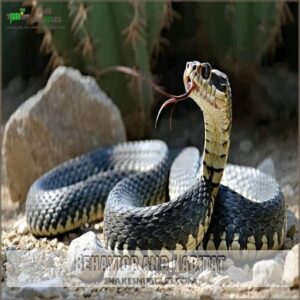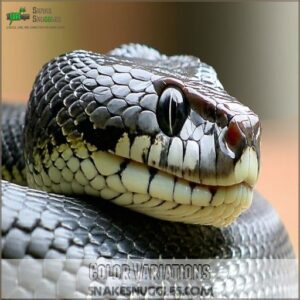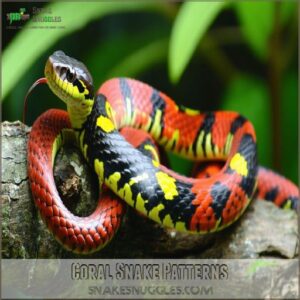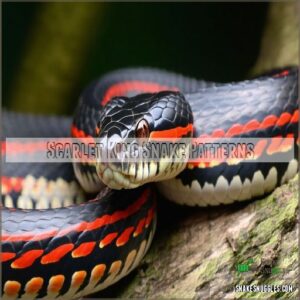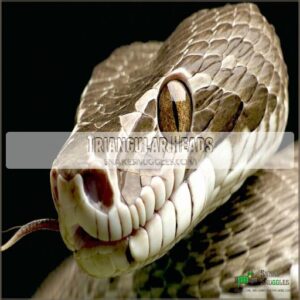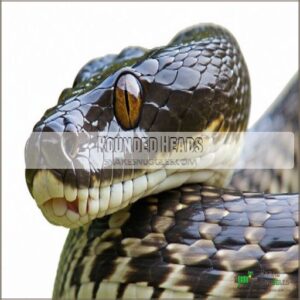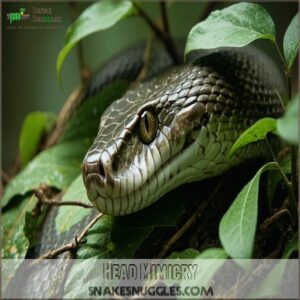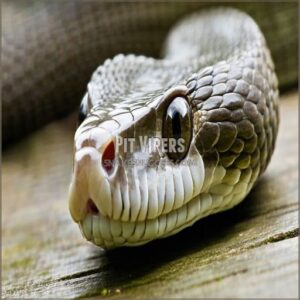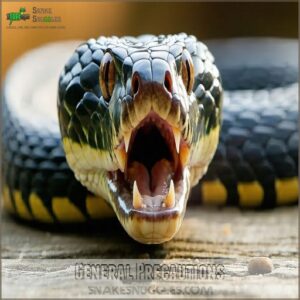This site is supported by our readers. We may earn a commission, at no cost to you, if you purchase through links.
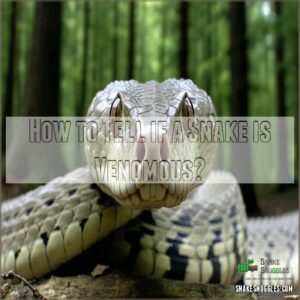 To tell if a snake is venomous, check for a triangular-shaped head and vertical pupils—features often seen in pit vipers.
To tell if a snake is venomous, check for a triangular-shaped head and vertical pupils—features often seen in pit vipers.
Heat-sensing pits between the eyes and nostrils are another giveaway.
Snakes like the coral snake sport bright, contrasting patterns, unlike their non-venomous lookalikes, such as the scarlet king snake.
Keep an ear out for any rattling tail, a clear warning sign!
But be cautious—some non-venomous snakes mimic these traits.
Curious for more tips and tales about these slippery critters? We’ve got more slithery secrets up our sleeve that might just save your skin in a snake encounter!
Table Of Contents
Key Takeaways
- Identify venomous snakes by looking for triangular-shaped heads and vertical pupils, but keep your distance to stay safe.
- Heat-sensing pits between the eyes and nostrils are common in pit vipers like rattlesnakes and copperheads; use these as indicators.
- Recognize color patterns such as the coral snake’s red touching yellow bands, but remember non-venomous snakes can mimic these traits.
- In case of a snake encounter, back away slowly and learn to differentiate local species using snake identification guides and resources.
How to Tell if a Snake is Venomous?
Ever wondered how to spot a venomous snake?
It’s all in the details.
Look for triangular-shaped heads and vertical pupils—though don’t get too close!
Heat-sensing pits can be a giveaway.
To learn more about snake identification, check out a snake identification book for reference.
Coral snakes, with their hourglass patterns, often send a clear message: beware.
Remember, some non-venomous snakes mimic these traits to trick predators, so it’s important to stay informed.
Use snake identification apps and resources to boost your confidence.
Knowledge is key to snake bite prevention and staying safe.
Behavior and Habitat
Understanding a snake’s behavior and habitat can help you assess the risk.
For example, a rattlesnake’s defensive posture in its usual rocky habitat is a stronger indicator than a garter snake’s nervous behavior in an unusual setting.
Warning Behaviors
Detecting a venomous snake? Pay attention to these warning behaviors: a snake rattling its tail or flattening its head is a classic no-go sign.
Watch for aggressive postures, sudden hissing sounds, or specific defensive movements.
They typically hang out near logs or rocks, so stay on your toes in such areas—no one likes surprises from a camouflaged neighbor!
Water Habitats
If you’re strolling by a pond or stream, keep your eyes peeled for water moccasins, creating a name for themselves among water snakes.
These aquatic snakes love hanging out near ponds, lakes, or streams.
Don’t just trust clear waters—snake habitats like damp ditches or debris piles can be homes, too.
Remember, safety begins with awareness in these inviting yet risky spots.
Wetland Areas
Picture copperheads chilling in wetland areas, those swampy spots where frogs abound.
These semi-aquatic pit vipers blend right in with their preferred humid habitats.
But don’t be fooled — they can wander considerable distances from water, hunting around like a tourist looking for the best burger joint.
Always be aware of these snakes thriving in such rich, lush ecosystems.
Body Patterns
When you’re trying to figure out if a snake is venomous, checking its body patterns can provide valuable clues.
Bold color variations, like those found on coral snakes, and mimicry patterns, such as those on scarlet king snakes, are often key indicators.
Color Variations
Some snakes wear vibrant hues like a warning flag, while others blend in like hidden ninjas.
Color variations can be tricky; lots of non-venomous snakes mimic their venomous cousins for safety.
To be smart about venomous snake identification, examine more than just colors.
Here’s how to read the signs:
- Camouflage Tactics
- Aposematic Coloring
- Mimicry Games
- Regional Variations
Coral Snake Patterns
Spotting a coral snake is key to staying safe from its potent venom. Look for bands where red touches yellow. These vibrant creatures are found in woodlands, hunting small reptiles and amphibians.
But human encroachment threatens their habitat. Familiarizing yourself with their patterns helps protect both you and these fascinating snakes. Coral snakes are primarily found in the southern half of Florida, including the Everglades region, and are most active during spring mating and fall dispersal seasons.
| Trait | Coral Snake | Scarlet King Snake | Habitat | Behavior |
|---|---|---|---|---|
| Red Touch Yellow | Yes | No | Wooded | Solitary |
| Venomous | Yes | No | Areas | Predator |
| Pattern | Bold | Varies | ||
| Reproduction | Slow | Moderate | ||
| Threats | Deforestation | Deforestation |
When you’re out and about, recognizing these pattern differences could save a life, yours or theirs. Stay curious and cautious!
Scarlet King Snake Patterns
Let’s talk about scarlet king snakes.
Their red bands touch black bands, unlike coral snakes where red touches yellow.
This mimicry is a clever defensive tactic.
King snakes aren’t venomous, but their markings help them avoid predators.
Remember, though, snake patterns aren’t foolproof for venomous snake identification.
Always be cautious!
Head Shape
When you’re checking out a snake, look at its head shape—it might give you clues about its venom status.
Just remember, some non-venomous snakes try to fool you with a triangular head too!
Triangular Heads
One popular clue for identifying venomous snakes is their triangular heads.
This shape houses venom glands and fangs, making them look a bit fierce and ready to strike.
But don’t let this fool you—some non-venomous snakes can mimic this feature.
So, always approach with caution and keep your distance to stay safe in the wild.
Rounded Heads
Most non-venomous snakes, like garden hoses in a wild world of potential threats, have rounded heads.
Yet, head shape isn’t a foolproof identifier.
Venomous pit vipers boast triangular heads, but beware—some non-venomous snakes play the shape-shifting game.
Always cross-check traits like round pupils and body patterns for safe identification, ensuring you spot a safe snake from afar.
Head Mimicry
Imagine this: you’re hiking and spot a snake with a triangular head shape.
Before you panic, consider mimicry evolution.
Non-venomous snakes, like the Scarlet King snake, use head shape deception to confuse predators.
These non-venomous mimics don’t have heat-sensing pits or vertical pupils, unlike their venomous counterparts.
It’s a clever defense but doesn’t mean they’re poisonous.
Pit Vipers
You might spot a Pit Viper by its broad, triangle-shaped head and distinct heat-sensing pits.
Rattlesnakes, Copperheads, and Cottonmouths all share these features, and keeping a safe distance is always a wise choice.
Rattlesnakes
Spotting a rattlesnake isn’t just about its iconic rattle.
Rattlesnakes are keen hunters.
With their triangular heads and heat-sensing pits,
these pit vipers hang out in various spots—dry deserts, lush forests, rocky ledges.
Remember, not all snakes with these features pack a venomous punch, but with rattlesnakes, caution is your best friend.
Copperheads
Copperheads, masters of disguise, lurk in wetlands, rocky hillsides, and even old buildings.
Their triangular heads and heat-sensing pits are key identifiers, but remember, many harmless snakes mimic their appearance.
For more accurate identification, consider a Copperhead identification kit.
Copperheads eat small animals.
A bite needs immediate medical attention because of their hemotoxic venom.
While not aggressive, give them a wide berth.
Cottonmouths
Cottonmouths, also known as water moccasins, love lurking in wetlands, boasting a bold, white mouth when threatened—a warning you shouldn’t ignore.
Recognizing their distinctive features is key, as venomous snake identification can mean the difference between life and death.
Their venom packs a punch, particularly during mating season when they’re on high alert.
If you’re near their habitat, respect their space.
Remember, they’re an important part of the ecosystem, playing a major role in its health.
Heat-Sensing Pits
Pit vipers have a unique trick up their sleeve: heat-sensing pits.
These specialized organs sit snugly between their eyes and nostrils, giving them an uncanny ability to track warm-blooded prey.
Imagine having infrared goggles built right into your face!
With this built-in heat radar, they can:
- Detect minute temperature changes
- Pinpoint prey precisely
- Sense their environment effectively
Pupil Shape
When checking a snake’s pupil shape, you might notice vertical slits resembling those of a cat’s eye, common in many venomous species like pit vipers.
However, don’t get too close—observing these tiny details isn’t safe, as some highly venomous snakes like coral snakes have round pupils.
Vertical Pupils
Sneaky and elusive, snakes have some nifty tricks up their sleeves—or scales!
One telltale sign of a venomous snake is its cat-eye pupil shape.
These vertical slits allow for excellent vision in low light, perfect for nocturnal hunters.
But take care—getting close enough to see can put you in harm’s way.
Always prioritize safety over curiosity!
Round Pupils
You spot a snake and think, "Are those round pupils?" Don’t jump to conclusions! Coral snakes have round pupils, but they’re venomous.
Here’s how you play it smart:
- Check the color bands—red and yellow can signify danger.
- Note the habitat; it matters.
- Don’t rely solely on pupil shape; it’s one piece in this reptilian puzzle.
Pupil Observation Caution
Spotting a snake’s pupil shape might seem helpful, but getting too close is asking for trouble.
Safety first—don’t let curiosity lead you into a snake’s personal space.
Light conditions and pupil dilation can often trick you, causing misidentification risks.
So, admire that snake’s elliptical pupils from afar, ensuring you’re safe while appreciating nature’s intriguing designs.
General Precautions
Remember, you shouldn’t handle snakes unless you’re an expert; even a seemingly dead snake can still bite, so always maintain a safe distance.
Avoiding Venomous Snakes
Encountering a venomous snake can be a real adventure in hiking safety.
Always back away slowly and give it plenty of space.
Don’t play hero by handling or approaching these sneaky critters.
Familiarize yourself with local venomous snake species and how to identify them—from their snake pupils to their unmistakable head shapes.
Utilize a snake identification guide, like those found at reliable snake guides, to learn more about the different species you may encounter.
Have a game plan ready for snakebite prevention, knowing where to find antivenom and first aid.
Keep those backyard precautions in mind, and you’ll enjoy nature without the drama!
| Local Species | Venomous? | Identifying Features |
|---|---|---|
| Rattlesnake | Yes | Rattle, pit vipers |
| Garter Snake | No | Rounded head, no pits |
| Coral Snake | Yes | Red touches yellow |
Caution With Dead Snakes
Regarding dead snakes, don’t let your guard down. A snake might be kaput, but those venom pockets are like cheddar—still sharp! Always keep a safe distance and call in the pros for removal.
It’s also essential to know how to prevent snake encounters in the first place by following simple snake safety precautions, such as those outlined in this snake health and safety guide. Here’s how to stay safe:
- Gently move it with a sturdy tool if necessary
- Get immediate medical help if bitten
- Skip those extraction kits and ice packs
- Wear protective gear like boots and long pants
- Consider snake repellents to keep your space snake-free
Stay smart and stay safe!
Frequently Asked Questions (FAQs)
How do you know if a snake is venomous?
Look for features like broad, triangular heads and slit-shaped pupils in pit vipers.
Bright colors might scream danger, but some non-venomous snakes mimic them.
Observing behavior isn’t foolproof, so use field guides and local expertise.
How to identify a venomous snake in the area?
Venomous snakes can be identified by their triangle heads, slit pupils, and distinct scales.
Some snakes might mimic these telltale signs.
Therefore, rely on local resources and experts to stay safe.
Do venomous snakes have round eyes?
Nope, pupil shape isn’t a reliable way to spot a venomous snake.
Some venomous snakes have round pupils, while others have slit-shaped ones.
Don’t rely on eye shape alone for identification!
What is the difference between a venomous snake and a non- venomous snake?
Spotting a venomous snake feels like solving a mysterious puzzle.
Notice triangular heads and slit pupils—pit vipers boast these traits.
Yet, beware of mimics, like the Scarlet King Snake, which cleverly imitates its venomous counterpart.
How can you tell if a snake is poisonous or not?
Check a snake’s head shape (broad, triangular heads like pit vipers), pupil shape (slit-like), and coloration (bright patterns often warn).
Remember, behavior isn’t a reliable indicator.
Always prioritize safety and avoid close encounters.
Conclusion
Approximately 15% of all snake species are venomous, so knowing how to tell if a snake is venomous can be very important, especially in the wild.
By observing features like heat-sensing pits, triangular heads, and distinctive color patterns, you can distinguish venomous snakes from harmless ones.
Always respect their habitats and use caution, even with dead snakes.
Stay informed and prepared, and these tips could help you safely navigate areas where these fascinating creatures live.

